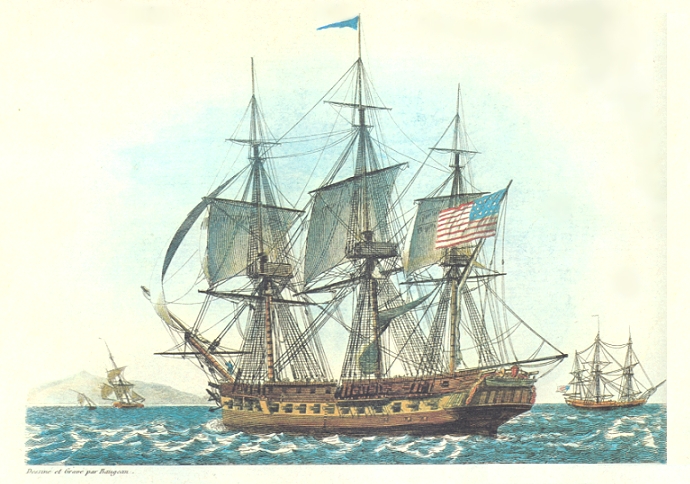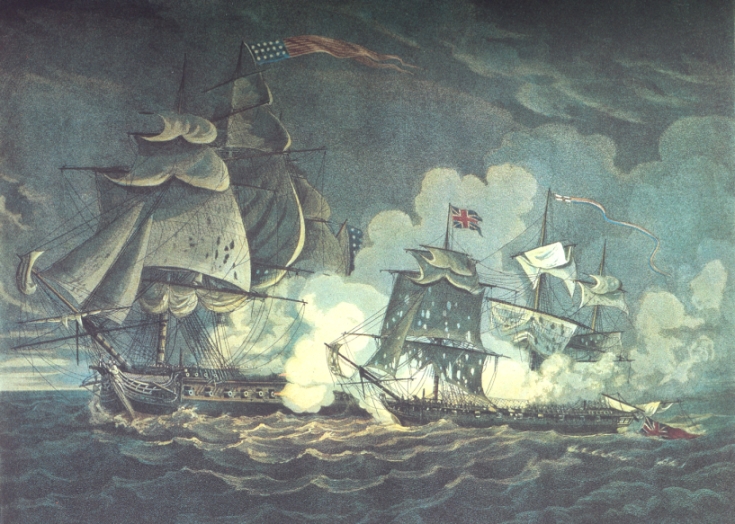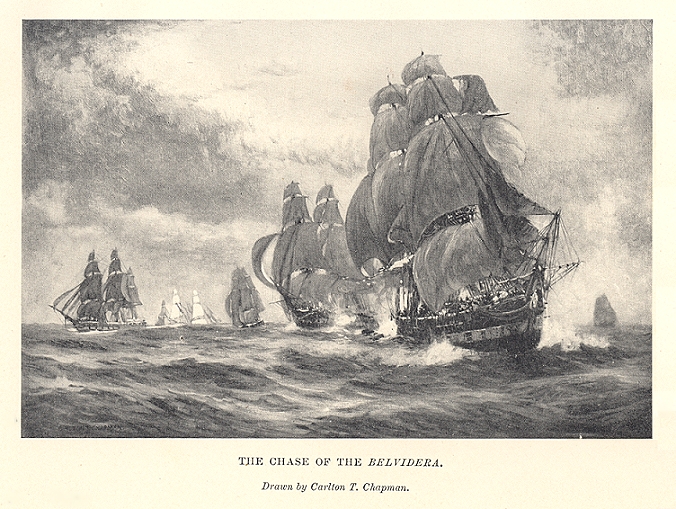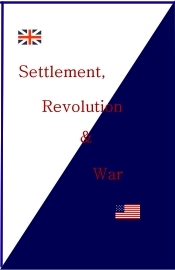
 Book #2: Settlement, Revolution & War.
Book #2: Settlement, Revolution & War.
![]()
The Little Belt and the President, May 16th, 1811
On April 19th, 1811, Vice-Admiral Sawyer, the Commander-in-chief at Bermuda issued instructions to Arthur Batt Bingham to
" ... seek out Captain Pechell in Guerrière1 somewhere along the Atlantic seaboard between Charlestown and New York. If he did not find him he was to cruise for as long as his supplies lasted and then repair to Halifax. He was to protect British trade and seek out enemy ships and he was asked to be particularly careful not to give any offence to the United States since relations between Great Britain and that country were particularly strained."2Bingham was the captain of the Little Belt (Lille Belt).3 She was originally in the Danish navy, but was taken by the British at Copenhagen on September 7th, 1807. She was set up by the British "with eighteen 32-pounder carronades4 and two long 9-pounders and had a complement of 121 officers, men and boys."5
In 1811 news was heard by Americans along their eastern seaboard that an American seaman had been pressed by a British frigate off Sandy Hook. Commodore John Roberts (b. 1771) in command of the 44-gun President was ordered to sea to protect American commerce. On the 16th of May, 1811 -- a full year before war broke out between the British and the Americans -- Roberts sighted and followed a British naval vessel. They were about 50 miles off of the entrance to Chesapeake Bay. The British naval vessel was the 20-gun Little Belt.

|
Joseph Allen tells us what happened next.
This event took place at about dusk, around 8 P.M.. Put aside the two questions -- Who started it? And, was it started by mistake? The fact is that both ships were "heavily engaged for half an hour." The outcome was predictable.
The two ships lay off for the rest of the night repairing damage, and at daylight of the 17th the President again closed with the Little Belt. A boat was sent over from the American frigate with a message to the effect that Commodore Rodgers regretted engaging so small an adversary but that he had mistaken the sloop for a frigate.9 And since, as he maintained, the Little Belt had fired the first gun, he had been forced to retaliate.
Though her masts, sails, rigging and upper works were badly damaged and with many shot holes in her sides, the Little Belt slowly made her way to Halifax arriving there on May 26th.10 At Halifax there was much excitement. War with the United States was now clearly on the horizon.
In his official report, Commodore Rodgers claimed that the British sloop had the appearance of a frigate. Further, it was the Little Belt that started the fight and it was up to the President to finish it. The American papers, as you might expect, sided with Rodgers. However, the American government did eventually admit responsibility and paid reparations. A hearing was conducted at Halifax where two British seaman, who had been on the President at the time, and who later "redeserted" to the British, gave evidence that the first shot was fired accidently by the President. She was like an overeager runner in the blocks, who started before the gun.
As for the Little Belt and Captain Bingham: On July 31st, Bingham took her with mail to England. She was paid off shortly after and sold at Deptford. The Admiralty had refused to try Captain Bingham by court-martial but expressed their full confidence in him and promoted him to post rank on 7th February 1812."11
A number of months were to pass as each side determined how best to deal with the other. Throughout these times the pressure was building between the two countries and once positions were taken neither one cared to back down.
On May 11th, 1812, the British Prime Minister, Perceval was assassinated in the lobby of the House of Commons. The Americans had nothing to do with that, of course; the deed was carried out by a deranged, bankrupt, Liverpudlian, businessman. The point is that there was a political upheaval at a critical time which distracted the boys at the top. Of course, the principal distraction was the war in Europe. The issue that Americans were not to be interfered with by British cruisers on the high seas, was one which was not getting enough attention in the British halls of power. The President of the United States, James Madison, and the American Congress decided to get this needed attention.
On June 18th, 1812, Congress passed a declaration of war, seventy-nine to forty-nine in the House of Representatives and nineteen to thirteen in the Senate, approving President Madison's recommendation. Britain determined to delay the counter move of making its own declaration, hoping that diplomacy might yet work. Britain declared war on the United States on January 9th, 1813. The parties, however, were in the fight earlier than that.
The delays in getting news across oceans in the days of sail meant that some people are in the know months before others.12 The American declaration of war was sent the same day to the United States Department of the Navy. "Within an hour a division of five ships was under way for sea."13 The fleet was under orders to stop and capture anything British. An under-protected trading convoy would be nice. Indeed, the American squadron had news that such a British convoy was but a few hundred miles away and downwind. The Americans, with canvas crowded on, went after their quarry. They whistled along, even though they carried heavy burdens of sea supplies. Then a large sail was sighted to the northeast, heading toward the squadron.
It is always a chase down wind when one square rigger is after another. In such circumstances, even a smaller ship has a good chance of getting away from her pursuer. The President, as fast and as well handled as she apparently was, could not catch up. What the Americans wanted was to put the President close enough, so to turn and level a broad side into the smaller Belvidera. However, in such a manoeuver, the President would lose her speed and the Belvidera would go out of range. The best the President could do was to use two chaser-guns, one just either side of her bow. The Belvidera had four cannon rolled out the stern galley windows, a place which provided room for the British crews to work their guns. Further, the recoil of the President's bow guns cut her speed by a small measure each time they went off; with every roar of her four stern-guns, the Belvidera got a boast in the right direction.
Captain Richard Byron, the officers, and men of the Belvidera were a plucky lot.16 After shaking off the American fleet and thinking that such an event had to mean that the expected war had become a fact, the Belvidera decided to make the most of the situation. "Two or three American merchantmen"17 were captured during the three day run back to Halifax and escorted them all into Halifax Harbour as "Prizes of War."
C. H. J. Snider, in his wonderful book, wrote how "on June 27th, 1812, Captain Richard Byron brought in his Majesty's Belvidera, all chewed up like a dog from a street fight. He had been chased and pummelled all day by an American squadron of five ships under Commodore Rodgers." Snider also reported that there were seventeen of the Belvidera's crew killed and wounded.18 Murdoch wrote, "two seaman were killed, four severely and eighteen slightly wounded ..."19 Both captains were wounded in the thigh, Byron by the carriage slide of a carronade breaking loose and Rodgers by an exploding gun.
Not too many days after the Belvidera came in with her report of having been chased by an American squadron, intelligence was received confirming that a state of war did indeed exist between Great Britain and the United States. At Halifax, Admiral Sawyer ordered the British warships which were at the ready to proceed to sea. On July 5th, a British squadron consisting of "one small ship of the line" and three frigates, the Shannon (38 guns), the Belvidera (36 guns) and the Aeolus (32 guns) went to sea. They were ordered to hang together as a squadron.20
"The President then shortened sail and hove to on the same tack, about eighty yards on the weather-beam of the corvette, and captain Bingham again hailed, and asked, 'What ship is that?' The hail was repeated, or rather re-echoed from the American frigate, as was also the question, 'What ship is that?' At this instant a gun was fired from each ship, but whether by accident or design, or from which ship first, remains, and will probably continue to be involved in doubt. Without further parley a cannonading then took place, which lasted about half an hour, when the Little Belt, from the loss of after-sail, fell off so that none of her guns would bear, and ceased firing. The President also ceased firing, when Commodore Rogers again hailed the British vessel, and was told, what he already was perfectly aware of, that her opponent was a British ship; but in reply to the question, 'Have you struck?' Captain Bingham answered in the negative.
The Little Belt had all her masts badly wounded, and her rigging and sails cut to pieces; there were many shot holes in her sides. Out of a crew of 121 men and boys, Samuel Woodward, midshipman, and ten men were killed; and acting Master James Franklin, and W.B. Hutchings, midshipman, and eight men and boys slightly wounded. Total: eleven killed and twenty-one wounded. The President, whose thick sides must have been impervious to the Little Belt's shot, had only one boy wounded."8

The Little Belt and the President
Wm. Elmes, painter & engraver, 1811.
The Belvidera and the American Fleet, June 24th, 1812
"The course of all vessels was changed for her; but she, proving to be British, -- The Belvidera, rated 32, and smaller than any one of the American frigates, -- speedily turned and took flight. Pursuit was continued all that day and until half an hour before midnight, the President leading as the fastest ship; but the British vessel, fighting for her life, and with the friendly port of Halifax under her lee, could resort to measures impossible to one whose plan of distant cruising required complete equipment, and full stores of provisions and water. Boats and spare spars and anchors were thrown overboard, and fourteen tons of drinking water pumped out."14

"The President closed the distance steadily; about four o'clock in the afternoon she fired three shots from her bow chasers which were aimed with such extraordinary accuracy that all took effect, two entering Byron's cabin just below where he stood, and one entering the gunroom below that. A sailor at the larboard stern-chaser was killed instantly and six others wounded, one mortally. Five minutes later the Belvidera had reorganised the guns' crews and returned the fire. The wind was light and she also made excellent and methodical practice, first carrying away a studding sail and then putting her shot among the guns' crews.
This event on the President, together with the industry of Belvidera's crew in throwing tons of equipment and provisions overboard, allowed the Belvidera to draw gradually away. As night fell, the Belvidera had increased the distance between herself and her pursers. On the morning of the next day, the American Fleet saw no sign of her. Although damaged by the bow-chasers of the President, the Belvidera had gotten away.
But the Americans shortly suffered a far more serious, self inflicted wound. One of President's bow-chasers exploded with awful results to the closely bunched men around, and also to the Commodore himself, who was cheering them on the fo'c'sle. Rodgers was carried away wounded."15
[NEXT: Pt. 5, Ch. 10 - "The Guerrière and the Constitution."]
